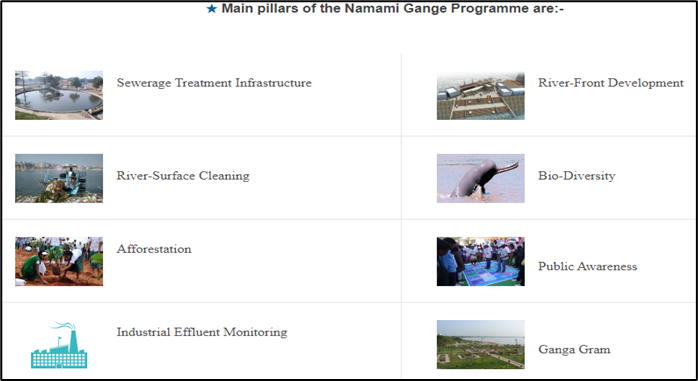Why in News?
- The Prime Minister of India recently highlighted the global appreciation for the country’s flagship Namami Gange Programme for Ganga rejuvenation, giving credit to people’s participation in the programme.
- The United Nations (UN) has recognised the initiative as one of the top 10 World Restoration Flagships and awarded it on 14th December 2022 - the World Restoration Day, at the COP15 to the CBD in Montreal, Canada.
What’s in today’s article:
- About Namami Gange Programme
- Why is the Namami Gange programme needed?
- Key achievements under the programme
About Namami Gange Programme:

- It is an integrated conservation mission, approved as ‘Flagship Programme’ by the Union Government in 2014 with budget outlay of Rs.20,000 Crores.
- It is administered by the Ministry of Jal Shakti's Department of Water Resources, River Development and Ganga Rejuvenation, to accomplish the twin objectives of -
- Effective abatement of pollution,
- Conservation and rejuvenation of National River Ganga.
- The program would be implemented by the National Mission for Clean Ganga (NMCG), and its state counterpart organisations i.e., State Program Management Groups (SPMGs).
- NMCG is the implementation wing of National Ganga Council (NGC, which replaced the National Ganga River Basin Authority).
- NGC was created in 2016 under the River Ganga (Rejuvenation, Protection and Management) Authorities Order, 2016, and is headed by the PM.
- In order to implement the programme, a three-tier mechanism has been proposed for project monitoring comprising of:
- A high-level task force chaired by Cabinet Secretary assisted by NMCG at the national level,
- State level committee chaired by Chief Secretary assisted by SPMG at the state level and
- District level committee chaired by the District Magistrate.
- Its implementation has been divided into -
- Entry-Level Activities (for immediate visible impact),
- Medium-Term Activities (to be implemented within 5 years of time frame) and
- Long-Term Activities (to be implemented within 10 years).
Why is the Namami Gange programme needed?
- Rising in the Himalayas and flowing to the Bay of Bengal, the river traverses a course of more than 2,500 km through the plains of north and eastern India.
- The Ganga basin - which also extends into parts of Nepal, China and Bangladesh - accounts for 26% of India's landmass.
- Thus, River Ganga has significant economic, environmental and cultural-spiritual value (one of India's holiest rivers), whose significance transcends the boundaries of the basin.
The key achievements under the programme are:
- Creating Sewage Treatment Capacity: 98 sewage projects have been completed in the states of UK, UP, Bihar, Jharkhand, West Bengal, etc.
- Creating River-Front Development: The projects for the construction, modernisation, and renovation of 267 Ghats/Crematoria and Kunds/Ponds have been initiated.
- River Surface Cleaning: River Surface cleaning for collection of floating solid waste from the surface of the Ghats and River and its disposal are afoot and pushed into service at 11 locations.
- Biodiversity Conservation: Cadre of volunteers (Ganga Praharis) have been developed and trained to support conservation actions in the field
- Public Awareness: Ganga Praharis and Ganga Doots are engaged in spreading awareness through planting trees, cleaning ghats, Ganga Aarti, painting and poems.
- Industrial Effluent Monitoring: Regulation and enforcement through regular and surprise inspections of Grossly Polluting Industries (GPIs) is carried out for compliance verification against stipulated environmental norms.
- Deploying best available knowledge and resources across the world: Countries such as Australia, United Kingdom, Germany, Finland, Israel, etc., have been collaborating with India for Ganga rejuvenation









